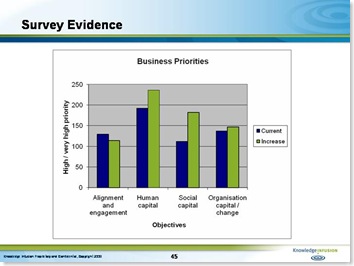 If you were on yesterday's webinar, over at Knowledge Infusion, I hope you enjoyed it.
If you were on yesterday's webinar, over at Knowledge Infusion, I hope you enjoyed it.
If you weren't, the slides and recording (available until 26th September) are here (if you're not already registered at KI's centre of excellence, you may have to do this first, but then if you're at all interested in HCM, you need to be on there anyway). And I know there'll be some more discussion on the COE, that I'll be joining in with, over the next few days.
But I also want to follow up with a post on the graph from that last slide (shown here) I didn't quite manage to get to. Because this is what my piece was all building up to, and I don't think people will have got quite the impact I was after without it.
The graph is from my social connecting survey. This has been running for a while, and I've not yet had time to analyse all the findings, so it's still running, and therefore these aren't the final results.
But what this graph shows is that current business priorities (the blue bar) are mainly about aligning and engaging people; developing human capital (attracting, developing and retaining staff) and organisation development / change.
But that social capital is going to get a lot more attention (an increase in priority - shown in the green bars) over the next five years. It may still be a lower business priority than human capital, which is increasing in importance too, but the increase in the importance of social capital compared to its current level is proportionately much higher than any of the other areas.
And I'd suggest, based upon the slide before this one, that that increase is still being underestimated too. My take on this is that those transformational opportunities I referred to in the webinar definitely exist. But I'd repeat the point I made at the end - I think these opportunities are about transforming through people (aided by technology), rather than transforming through technology. It's an important distinction.
Try to transform by technology and you get to the mess we got into when we all tried to focus on pure e-learning, before we all learned that a blended approach is best. And some organisations are making this mistake. The examples I gave during the session were all about recruitment, and there's a great expose of the mess recruiters can get themselves into by focusing too much on the technology in FOT (it's something Krishna mentioned in our podcast on Monday too).
The opportunity is about connections, or as Jason put it, interactions rather than transactions (see, I was listening really!). And I think that leads to taking one of two choices when implementing digital HR.
Either, you accept your business isn't going to value connections (and if it currently bans Facebook, it's a good sign that it's not) and do want you can with the technology. But because there's no clear business benefit, you're going to have to do it carefully, sneaking it in under the radar and hoping people don't notice it's 2.0.
Or you make a big play on connections / interactions / social capital, and you get the business to understand how important this is. This can then lead into a significant change programme, and a big launch for the new technology. But the activities themselves are going to involve a mix of physical as well as technological approaches (ie be blended again).
In my survey, physical activities, particularly team meetings are currently rated the most popular, and team meetings plus social events the most effective. But people expect the greatest increase in activity over the next five years to be in more traditional (non 2.0) IT systems such as knowledge management systems and corporate directories, and in web 2.0 technologies as well. And they expect a decrease in the number of team meetings. Why is this if team meetings are currently rated most effective? I presume it's because they expect to get better at using and leveraging social technologies over time. But if you think there's something else to it, do let me know.
As further evidence of this, I'd point to the Internal Communication conference I attended this June. The best case studies, to me, were the ones where the organisations clearly had some appreciation of the value of connecting, and had made a big thing of the launch (Microsoft being a particularly powerful example). Others clearly didn't have this perception and implemented web 2.0 using a stealth approach. Of course, there were also examples to prove the rule - BT clearly understands the value of connecting, but still started their programme off 'under the radar'.
I also think this relates to the debate on whether you link web 2.0 to a key strategic programme, and introduce all the technology that's going to be useful in supporting this at once (yes - if the programme is about connecting , or an outcome of connecting eg collaboration or innovation), or just introduce one particular technology eg expert Q&A, and find as many uses for this technology as you can (yes - if there's no real or perceived value attached to connecting).
Oh, one more thing. I am going to close the survey at the end of September, but if you're reading this before then, do go into survey monkey and complete it. The survey is available here: www.snipurl.com/socialconnecting.
I will be posting summary results on this blog, but if you want the full analysis in all it's glory, you'll need to participate in the survey (or just be very nice to me, and I'll probably still send it to you direct).



















No comments:
Post a Comment
Please add your comment here (email me your comments if you have trouble and I'll put them up for you)